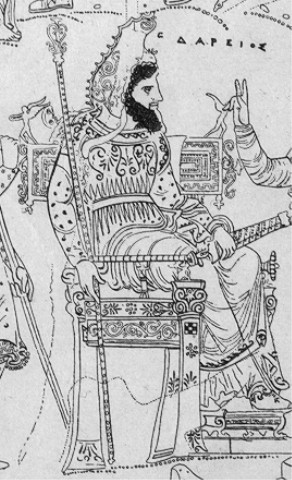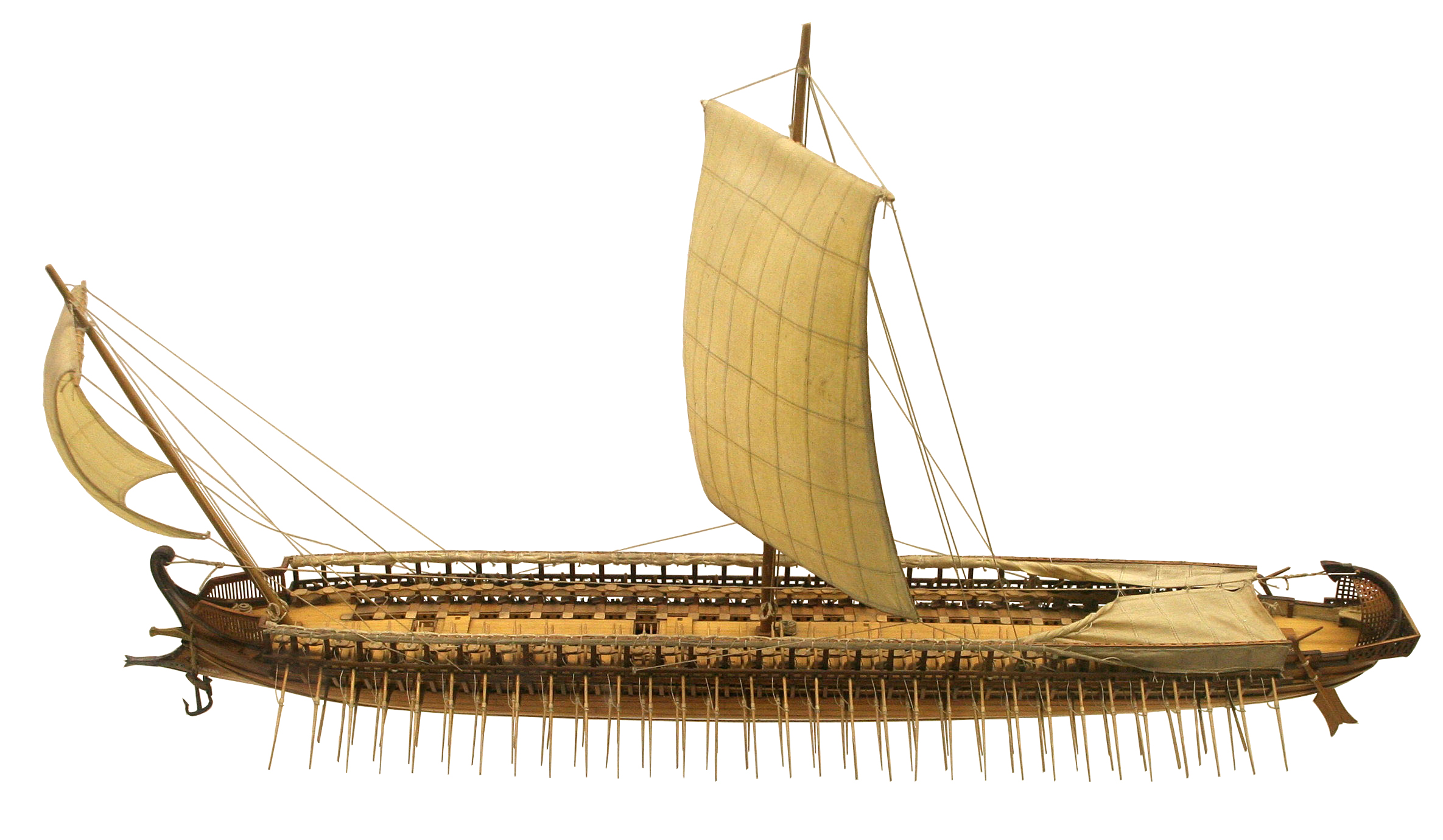|
Siege Of Eretria
The siege of Eretria took place in 490 BC, during the first Persian invasion of Greece. The city of Eretria, on Euboea, was besieged by a strong Persian force under the command of Datis and Artaphernes. The first Persian invasion was a response to Greek involvement in the Ionian Revolt, when the Eretrians and Athenians had sent a force to support the cities of Ionia in their attempt to overthrow Persian rule. The Eretrian and Athenian force had succeeded in capturing and burning Sardis (the regional capital of Persia), but was then forced to retreat with heavy losses. In response to this raid, the Persian king Darius I swore to have revenge on Athens and Eretria. Once the Ionian revolt was finally crushed by the Persian victory at the Battle of Lade, Darius began to plan to subjugate Greece. In 490 BC, he sent a naval task force under Datis and Artaphernes across the Aegean to subjugate the Cyclades, and then to make punitive attacks on Athens and Eretria. Reaching Euboea in mid ... [...More Info...] [...Related Items...] OR: [Wikipedia] [Google] [Baidu] |
Greco-Persian Wars
The Greco-Persian Wars (also often called the Persian Wars) were a series of conflicts between the Achaemenid Empire and Greek city-states that started in 499 BC and lasted until 449 BC. The collision between the fractious political world of the Greeks and the enormous empire of the Persians began when Cyrus the Great conquered the Greek-inhabited region of Ionia in 547 BC. Struggling to control the independent-minded cities of Ionia, the Persians appointed tyrants to rule each of them. This would prove to be the source of much trouble for the Greeks and Persians alike. In 499 BC, the tyrant of Miletus, Aristagoras, embarked on an expedition to conquer the island of Naxos, with Persian support; however, the expedition was a debacle and, preempting his dismissal, Aristagoras incited all of Hellenic Asia Minor into rebellion against the Persians. This was the beginning of the Ionian Revolt, which would last until 493 BC, progressively drawing more regions of Asia Minor into the co ... [...More Info...] [...Related Items...] OR: [Wikipedia] [Google] [Baidu] |
Ardericca In Susiana
Ardericca in Susiana (also spelled Arderikka; grc, Ἀρδέρικκα) was an ancient village in Cissia (area), Cissia mentioned by Herodotus (6.119.2). Described as being located about 40 km from Susa, it is noted for being the location where the Achaemenid Empire, Achaemenid king Darius I (r. 522-486 BC) settled the inhabitants of Eretria, after the city was taken by his admiral Datis in 490 BC. The site is commonly identified with the modern-day place of "Kīr-āb", located to the north of Susa. Herodotus further states that the village was famous for a spring located 7 km from it, where salt, oil and asphalt were produced. He also described it as being a ''stathmos'' ("farmstead") of Darius I, implying that Ardericca in Susiana was perhaps one of the king's own estates. Herodotus also mention that the Eretrians were still living there during his time and they were speaking Greek. References Sources * * Achaemenid cities Former populated places in Khuzestan ... [...More Info...] [...Related Items...] OR: [Wikipedia] [Google] [Baidu] |
Propontis
The Sea of Marmara,; grc, Προποντίς, Προποντίδα, Propontís, Propontída also known as the Marmara Sea, is an inland sea located entirely within the borders of Turkey. It connects the Black Sea to the Aegean Sea via the Bosporus and Dardanelles straits, separating the country's European and Asian sides. The Sea of Marmara is a small sea with an area of , and dimensions of . Its greatest depth is . Name The Sea of Marmara is named after the largest island to its south side which is called Marmara Island because it is rich in marble (Greek (''mármaron'') "marble)." In classical antiquity it was known as the Propontis, which is derived from the Greek words ''pro-'' (before) and ''pontos'' (sea) and reflects the fact that the Ancient Greeks used to sail through it to reach the Black Sea that they called Pontos. Mythology In Greek mythology, a storm on the Propontis brought the Argonauts back to an island they had left, precipitating a battle in which ... [...More Info...] [...Related Items...] OR: [Wikipedia] [Google] [Baidu] |
Chalcis
Chalcis ( ; Ancient Greek & Katharevousa: , ) or Chalkida, also spelled Halkida (Modern Greek: , ), is the chief town of the island of Euboea or Evia in Greece, situated on the Euripus Strait at its narrowest point. The name is preserved from antiquity and is derived from the Greek χαλκός (copper, bronze), though there is no trace of any mines in the area. In the Late Middle Ages, it was known as Negropont(e), an Italian name that has also been applied to the entire island of Euboea. History Ancient Greece The earliest recorded mention of Chalcis is in the Iliad, where it is mentioned in the same line as its rival Eretria. It is also documented that the ships set for the Trojan War gathered at Aulis, the south bank of the strait near the city. Chamber tombs at Trypa and Vromousa dated to the Mycenaean period were excavated by Papavasiliou in 1910. In the 8th and 7th centuries BC, colonists from Chalcis founded thirty townships on the peninsula of Chalcidice and ... [...More Info...] [...Related Items...] OR: [Wikipedia] [Google] [Baidu] |
Miletus
Miletus (; gr, Μῑ́λητος, Mī́lētos; Hittite transcription ''Millawanda'' or ''Milawata'' (exonyms); la, Mīlētus; tr, Milet) was an ancient Greek city on the western coast of Anatolia, near the mouth of the Maeander River in ancient Ionia. Its ruins are located near the modern village of Balat in Aydın Province, Turkey. Before the Persian rule that started in the 6th century BC, Miletus was considered among the greatest and wealthiest of Greek cities. Evidence of first settlement at the site has been made inaccessible by the rise of sea level and deposition of sediments from the Maeander. The first available evidence is of the Neolithic. In the early and middle Bronze Age the settlement came under Minoan influence. Legend has it that an influx of Cretans occurred displacing the indigenous Leleges, and the site was renamed Miletus after a place in Crete. Recorded history at Miletus begins with the records of the Hittite Empire, and the Mycenaean records of ... [...More Info...] [...Related Items...] OR: [Wikipedia] [Google] [Baidu] |
Aristagoras
Aristagoras ( grc-gre, Ἀρισταγόρας ὁ Μιλήσιος), d. 497/496 BC, was the leader of the Ionian city of Miletus in the late 6th century BC and early 5th century BC and a key player during the early years of the Ionian Revolt against the Persian Achaemenid Empire. He was the son-in-law of Histiaeus, and inherited the tyranny of Miletus from him. The Greeks had won the coast of Asia Minor from the preceding Hittite Empire during the Bronze Age, and thanks to their victory at Troy had kept it during the fall of the empire and retirement of the Hittites to Syria. They shared the coast with the Phrygians (proto-Armenians) coming in from the Balkans, but neither were prepared for the mass emigration of Iranians from the plains of Asia. Ionia appealed to the mainland Greeks for assistance and not receiving it were forced to capitulate, becoming subjects of the new Achaemenid Empire. As long as they paid their taxes and were no threat to the rule of the Persians, the l ... [...More Info...] [...Related Items...] OR: [Wikipedia] [Google] [Baidu] |
Milesians (Greek)
The Milesians were the inhabitants of Miletus, an ancient Greek city in Anatolia, modern-day Turkey, near the coast of the Mediterranean Sea and at the mouth of the Meander River. Settlers from Crete moved to Miletus sometime in 16th century BC. By the 6th century BC, Miletus had become a maritime empire, and the Milesians spread out across Anatolia and even as far as the Crimea and Olbia, Ukraine, founding new colonies. Noted Milesians: * Miletus, the mythological founder of the city * Cadmus of Miletus, a historian, perhaps mythical * Arctinus of Miletus, 8th century BC Greek epic poet * Thales (c. 624–c. 546 BC), considered by many the "first" Greek natural philosopher; "the father of science" * Anaximander (c. 610–c. 546 BC), philosopher; pupil of Thales * Anaximenes of Miletus (c. 585–c. 528 BC), philosopher; friend or pupil of Anaximander * Hecataeus of Miletus (c. 550–c. 476 BC), historian * Hippodamus of Miletus (498–408 BC), Greek architect, urban planner, ph ... [...More Info...] [...Related Items...] OR: [Wikipedia] [Google] [Baidu] |
Artaphernes
Artaphernes ( el, Ἀρταφέρνης, Old Persian: Artafarna, from Median ''Rtafarnah''), flourished circa 513–492 BC, was a brother of the Achaemenid king of Persia, Darius I, satrap of Lydia from the capital of Sardis, and a Persian general. In his position he had numerous contacts with the Greeks, and played an important role in suppressing the Ionian Revolt. Biography First contacts with Athens (507 BC) In 507 BC, Artaphernes, as brother of Darius I and Satrap of Asia Minor in his capital Sardis, received an embassy from Athens, probably sent by Cleisthenes, which was looking for Persian assistance in order to resist the threats from Sparta. Artaphernes asked the Athenians for "Earth and Water", a symbol of submission, if they wanted help from the Achaemenid king. The Athenians ambassadors apparently accepted to comply, and to give "Earth and Water". Artaphernes also advised the Athenians that they should receive back the Athenian tyrant Hippias. The Persians threat ... [...More Info...] [...Related Items...] OR: [Wikipedia] [Google] [Baidu] |
Naxos (island)
Naxos (; el, Νάξος, ) is a Greek island and the largest of the Cyclades. It was the centre of archaic Cycladic culture. The island is famous as a source of emery, a rock rich in corundum, which until modern times was one of the best abrasives available. The largest town and capital of the island is Chora or Naxos City, with 7,374 inhabitants (2011 census). The main villages are Filoti, Apiranthos, Vivlos, Agios Arsenios, Koronos and Glynado. Geography Climate Naxos experiences a Mediterranean climate, with relatively mild winters and warm summers. The Köppen Climate Classification subtype for this climate is "Csa". (Mediterranean Climate). Inland areas of the island are much wetter and cooler in winter. Mythic Naxos According to Greek mythology, the young Zeus was raised in a cave on Mt. Zas ("''Zas''" meaning "''Zeus''"). Homer mentions " Dia"; literally the sacred island "of the Goddess". Károly Kerényi explains: One legend has it that in the ... [...More Info...] [...Related Items...] OR: [Wikipedia] [Google] [Baidu] |
Siege Of Naxos (499 BC)
The siege of Naxos (499 BC) was a failed attempt by the Milesian tyrant Aristagoras, operating with support from, and in the name of the Persian Empire of Darius the Great, to conquer the island of Naxos. It was the opening act of the Greco-Persian Wars, which would ultimately last for 50 years. Aristagoras had been approached by exiled Naxian aristocrats, who were seeking to return to their island. Seeing an opportunity to bolster his position in Miletus, Aristagoras sought the help of his overlord, the Persian king Darius the Great, and the local satrap, Artaphernes to conquer Naxos. Consenting to the expedition, the Persians assembled a force of 200 triremes under the command of Megabates. The expedition quickly descended into a debacle. Aristagoras and Megabates quarreled on the journey to Naxos, and someone (possibly Megabates) informed the Naxians of the imminent arrival of the force. When they arrived, the Persians and Ionians were thus faced with a city well prepared to ... [...More Info...] [...Related Items...] OR: [Wikipedia] [Google] [Baidu] |







